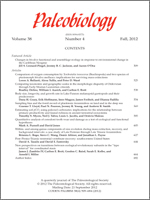We investigate potential microevolutionary mechanisms of phenotypic change in a lineage of brackish-water gastropods from Lake Pannon. The lineage exhibits a threefold increase in body size and a pronounced increase in shell shouldering over a roughly 2.5-Myr interval. We use the stable oxygen isotope profiles of 13 shells to address the question of whether large size is due to more rapid growth or to greater longevity.
Results indicate that larger individuals have significantly greater longevity. Growth rates in large snails are comparable to those of their smaller-bodied ancestors.
Potentially relevant selective advantages of large size include escape from predators, avoidance of resource competition, and increased fecundity. We argue that the first two advantages may have accrued to larger individuals but are not likely to have driven the trend because selection for them would favor more rapid growth rates. Fecundity selection, on the other hand, is readily envisioned in a stable, predictable environment in which the need for early reproduction is relaxed. The evolution of large body size in Lake Pannon molluscs may be comparable to evolution on many islands, where reduced pressure from competition and predation lead to characteristic changes in body size.





